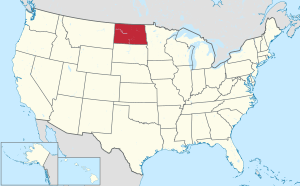List of census-designated places in North Dakota facts for kids
Imagine a community that feels like a town but isn't officially a city or village. That's pretty much what a Census-Designated Place, or CDP, is! In North Dakota, there are 44 of these special places. They are areas where many people live together, but they don't have their own elected local government or official city limits.
Contents
What is a Census-Designated Place?
A Census-Designated Place (CDP) is a special area that the United States Census Bureau defines. They do this to collect information about people living in places that aren't official cities or towns. Think of it as a neighborhood or a small community that the government wants to count.
Why are CDPs important?
Even though CDPs don't have their own mayors or city councils, counting their populations is very important. This information helps the government understand where people live. It also helps decide where to put things like schools, roads, and other public services. It's all about making sure everyone is counted and gets the support they need.
How are CDPs different from cities?
The main difference is that a CDP doesn't have its own official government. A city or town has elected leaders, like a mayor and a city council. These leaders make decisions about local laws, services, and taxes. In a CDP, these decisions are usually made by the larger county government.
Census-Designated Places in North Dakota
North Dakota has 44 Census-Designated Places. These places range from large communities to very small ones. The 2010 census helped us understand how many people live in each of these unique areas.
Largest CDPs
Some of North Dakota's CDPs are quite large. For example, Minot Air Force Base is the biggest CDP. It had over 5,500 people living there in 2010. Another large one is Grand Forks Air Force Base, with more than 2,300 residents. These are military bases where many families live. Belcourt is another significant CDP, home to over 2,000 people.
Smaller CDPs
Many CDPs in North Dakota are much smaller. Some have fewer than 100 people. For instance, places like McLeod and Blanchard had only a handful of residents in 2010. These smaller communities are often rural and spread out.
How populations change
The number of people living in these places can change over time. The census helps track these changes. Some CDPs might grow, while others might see their population shrink. This information is useful for planning for the future of these communities.
Images for kids



